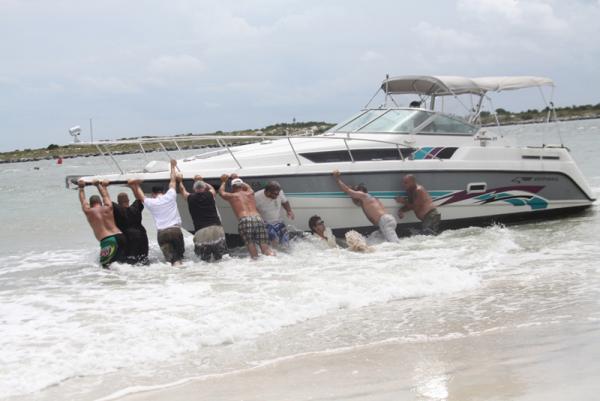
You’ve been sailing awhile and in what you thought were familiar waters, when, you hear that terrible sound.
Here’s a great article by William C. Winslow, the Division 5 – Staff Officer Public Affairs, First District Southern Region, for the U.S. Coast Guard Auxiliary, the all-volunteer, non-military arm of the Coast Guard, teaching boating safety education and conducting search and rescue operations
Crunch! You have just run aground. You feel embarrassed to do so in view of your family and friends, and your ego is dinged.
Welcome to the club — you’re not really a true boater until you have experienced a scraping. What distinguishes an old salt from a newbie is what you do to minimize your bad luck, and how you get unstuck when you’re in too-thin water.
Skippers’ errors turn into trouble when they ignore signs of danger or indulge in risky navigational behavior such as not paying attention to where they are headed. So how to keep the captain alert?
- A depth finder should be standard equipment on all but the smallest craft. The depth finder should be set so an alarm rings if the water drops to a predetermined depth (be generous with that setting by allowing an extra three to four feet). Even the smallest runabout should have a boat hook or even an oar to gauge the water’s depth.
- Have paper charts aboard. They provide the big picture of bottom conditions in far more detail than electronic ones often do and help the helmsperson plot a course around potential hazards.
- Know the sea conditions for your boating day. When is high and low tide? How strong is the wind and where are the currents and locations of known rip tides? Make use of all information known before you set out and use electronics and available apps to monitor any changing conditions during your cruise.
- Know the environment you’ll be boating in by checking the slope of tidal sand bars. If they slope gradually, they will likely continue quite a way under water. If you spot birds wading out some distance from shore, conclude that they are in shallow water. Risking a shortcut over a sandbar may work one day, but subtle changes in tide, wind, and/or waves might spell disaster during another trip.
What if you have been cautious and you still got hung up? The kind of bottom you hit and how fast you were going play key roles in whether you’ll successfully free your vessel quickly with the loss of little more than a bit of bottom paint.
At the first sound of grounding you should cut your engine to avoid plowing in deeper. Then the skipper or a knowledgeable crewmember should check to see if the vessel has been holed. Even a two-inch gash can let a lot water in. Plug that hole with anything you have, including clothes, rags, towels, life jackets, and sails.
A soft landing indicates you’re in sand or mud, but look over your railing to confirm: If you’re sitting in mud or sand, you may have some wiggle room. Retracing your route makes sense here — until you scraped, you were in clear water, so backing out may be all that’s needed. If that doesn’t work, try turning around 180 degrees. You just might be able to bull your way through because your engine is more powerful in forward than reverse (first make a quick choice as to whether deeper water is to port or starboard). If your boat is a small open runabout with a draft of no more than a foot or so, another way to get free is to have everybody get into the water and push the craft back into deeper water.
Rocks confront you with a different challenge as they are unforgiving. Moving forward or back may do serious damage to the keel; once on a rock, always on a rock until the tide changes.
There are a number of other options for the level-headed skipper to consider. If the tide is coming in, you can float off, but put out an anchor to hold the boat in place so the wind or current doesn’t push your vessel into deeper danger. If the tide is ebbing, you will be spending up to eight hours immobilized while facing an increasing list. As this could flood the boat, it’s time to call for a professional tow. Though you hope you’ll never need it, it’s smart to buy unlimited towing at the beginning of each season.